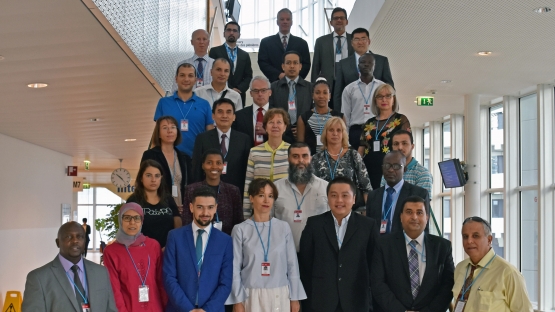Twenty-nine professionals from regulatory and waste management organizations in 18 countries have developed a greater understanding of the challenges related to the transport of radioactive sources at a meeting held in Vienna from 28 to 31 August this year. The meeting, organized under the umbrella of an IAEA technical cooperation project[1] that focuses on cradle-to-grave management of Sealed Radioactive Sources (SRS), provided the participating Member States with a comprehensive overview of the transport safety requirements at each stage in the life cycle of sealed radioactive sources.
Radioactive sources are used all over the world in activities related to human health, food production, research, or environmental monitoring, among many others. To reach the facilities where SRS are used, they must be first transported. SRS may need to be moved from country to country, or within a country, and transport issues are also an important consideration in the end-of-life management of a source. At this stage in a source’s lifecycle, it must be transported from the end-user facility to the storage or recycling facility, transferred to a disposal facility, or removed from the country for repatriation.
“Transport is essential to ensuring cradle-to-grave control of radioactive sources; ensuring safe transport is a paramount activity that needs to be properly addressed. If transport is done safely, both the parties sending and receiving a radioactive source can be assured that all safety standards are met”, said Stephen Whittingham, Unit Head of the IAEA’s Transport Safety Unit.
Meeting participants heard a range of presentations designed to review the safety and regulatory requirements for transport, address knowledge gaps, and present the challenges faced by Member States.
“There are many challenges related to transport” said Abrie Visagie, one of the international experts who supported the facilitation of the meeting. “More attention should be paid to transport activities to avoid future problems“, said Bob Irwin, another expert attending the meeting.
The participants used the meeting to hold active discussions with the IAEA experts, and with each other. The discussions served to share best practices and exchange information, so Member States could learn from each other.
“This approach is essential for countries to learn from each other and to create a needed harmonization of regulations and practices throughout the world”, remarked Paul Gray, an international expert from Canada.
The technical cooperation project helps participating Member States to strengthen their national capacities and capabilities to manage Sealed Radioactive Sources, while following a harmonized approach based on the IAEA Safety Standards. The project receives extensive technical and financial support from the European Union, Spain and the United States.
The 18 countries which took part in this project are as follows: Canada, South Africa, United States of America, Albania, Bosnia and Herzegovina, Brazil, Bulgaria, Cuba, Cyprus, Egypt, Ghana, Jordan, Lebanon, Libya, the former Yugoslav Republic of Macedonia, Malaysia, Montenegro, Morocco, Slovenia, Serbia, and Turkey.
__________
[1] INT9182: Sustaining Cradle-to-Grave Control of Radioactive Sources





